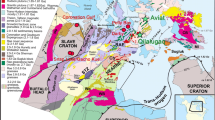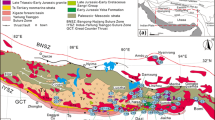Abstract
Here we present new data from a systematic Sr, Nd, O, C isotope and geochemical study of kimberlites of Devonian age Mirny field that are located in the southernmost part of the Siberian diamondiferous province. Major and trace element compositions of the Mirny field kimberlites show a significant compositional variability both between pipes and within one diatreme. They are enriched in incompatible trace elements with La/Yb ratios in the range of (65–300). Initial Nd isotope ratios calculated back to the time of the Mirny field kimberlite emplacement (t = 360 ma) are depleted relative to the chondritic uniform reservoir (CHUR) model being 4 up to 6 ɛNd(t) units, suggesting an asthenospheric source for incompatible elements in kimberlites. Initial Sr isotope ratios are significantly variable, being in the range 0.70387–0.70845, indicating a complex source history and a strong influence of post-magmatic alteration. Four samples have almost identical initial Nd and Sr isotope compositions that are similar to the prevalent mantle (PREMA) reservoir. We propose that the source of the proto-kimberlite melt of the Mirny field kimberlites is the same as that for the majority of ocean island basalts (OIB). The source of the Mirny field kimberlites must possess three main features: It should be enriched with incompatible elements, be depleted in the major elements (Si, Al, Fe and Ti) and heavy rare earth elements (REE) and it should retain the asthenospheric Nd isotope composition. A two-stage model of kimberlite melt formation can fulfil those requirements. The intrusion of small bodies of this proto-kimberlite melt into lithospheric mantle forms a veined heterogeneously enriched source through fractional crystallization and metasomatism of adjacent peridotites. Re-melting of this source shortly after it was metasomatically enriched produced the kimberlite melt. The chemistry, mineralogy and diamond grade of each particular kimberlite are strongly dependent on the character of the heterogeneous source part from which they melted and ascended.







Similar content being viewed by others
References
Agashev AM, Orihashi Y, Watanabe T, Pokhilenko NP, Serenko VP (2000) Isotope-geochemical features of the Siberian Platform kimberlites in connection with the problem of their origin. Russ Geol Geophys 41(1):87–97
Agashev AM, Watanabe T, Bydaev DA, Pokhilenko NP, Fomin AS, Maehara K, Maeda J (2001) Geochemistry of kimberlites from the Nakyn field, Siberia: evidence for unique source composition. Geology 29:267–270
Agashev AM, Pokhilenko NP, Malkovetz VG, Sobolev NV (2006) Sm–Nd isotopic system in garnet megacrysts from the Udachnaya kimberlite pipe (Yakutia) and petrogenesis of kimberlites. Dokl Earth Sci 407:491–494
Agashev AM, Pokhilenko NP, Takazawa E, McDonald JA, Vavilov MA, Watanabe T, Sobolev NV (2008) Primary melting sequence of a deep (>250 km) lithospheric mantle as recorded in the geochemistry of kimberlite-carbonatite assemblages, Snap Lake dyke system, Canada. Chem Geol 255:317–328
Agashev AM, Orihashi Y, Pokhilenko NP, Serov IV, Tolstov AV, Nakai S (2016) Age of Mirny field kimberlites (Siberia) and application of Rutile and Titanite for U–Pb dating of kimberlite emplacement by LA-ICP-MS. Geochem J 50:431–438
Becker M, Le Roex AP (2006) Geochemistry of south African on- and off-craton, Group I and Group II kimberlites: petrogenesis and source region evolution. J Petrol 47:673–703
Bussweiler Y, Foley SF, Prelević D, Jacob DE (2015) The olivine macrocryst problem: new insights from minor and trace element compositions of olivine from Lac de Gras kimberlites, Canada. Lithos 220–223:238–252
Carlson RW, Czamanske G, Fedorenko V, Ilupin I (2006) A comparison of Siberian meimechites and kimberlites: implications for the source of high-Mg alkalic magmas and flood basalts. Geochem Geophys Geosyst 7:Q11014
Clement CR, Skinner EMW (1985) A textural genetic classification of kimberlites. Trans Geol Soc S Afr 88:403–409
Davis GL, Sobolev NV, Khar'kiv AN (1980) New data on Yakytian kimberlites age obtained by U–Pb method on zirkons. Dokl Akad Nauk 254(1):175–179
Deines P (1989) Stable isotope variations in carbonatites. In: Bell K (ed) Carbonatites: genesis and evolution. Unwin Hyman, London, pp 301–359
Deines P (2002) The carbon isotope geochemistry of mantle xenoliths. Earth Sci Rev 58:247–278
Demeny A, Ahijado A, Casillas R, Vennemann TW (1998) Crustal contamination and fluid/rock interaction in the carbonatites of Fuerteventura (Canary Islands, Spain): a C, O, H isotope study. Lithos 44:101–115
Duke GI, Carlson RW, Frost CD, Hearn BC Jr, Eby GN (2014) Continent-scale linearity of kimberlite–carbonatite magmatism, mid-continent North America. Earth Planet Sci Lett 403:1–14
Faure G (1986) Principles of isotope geology. Wiley, New York
Giuliani A, Kamenetsky VS, Phillips D, Kendrick MA, Wyatt BA, Goemann K (2012) Nature of alkali-carbonate fluids in the sub-continental lithospheric mantle. Geology 40:967–970
Giuliani A, Phillips D, Kamenetsky VS, Fiorentini ML, Farquhar J, Kendrick MA (2014) Stable isotope (C, O, S) compositions of volatile-rich minerals in kimberlites: a review. Chem Geol 374:61–83
Giuliani A, Phillips D, Woodhead JD, Kamenetsky VS, Fiorentini ML, Maas R, Soltys A, Armstrong RA (2015) Did diamond-bearing orangeites originate from MARID-veined peridotites in the lithospheric mantle? Nat Commun 6:6837
Giuliani A, Phillips D, Kamenetsky VS, Goemann K (2016) Constraints on kimberlite ascent mechanisms revealed by phlogopite compositions in kimberlites and mantle xenoliths. Lithos 240–243:189–201
Giuliani A, Soltys A, Phillips D, Kamenetsky VS, Maas R, Goemann K, Woodhead JD, Drysdale RN, Griffin WL (2017) The final stages of kimberlite petrogenesis: petrography, mineral chemistry, melt inclusions and Sr-C-O isotope geochemistry of the Bultfontein kimberlite (Kimberley, South Africa). Chem Geol 455:342–356
Haggerty SE (1994) Superkimberlites: a geodynamic diamond window to the Earth's core. Earth Planet Sci Lett 122:57–69
Hofmann AW (1997) Mantle geochemistry: the message from oceanic volcanism. Nature 385:219–229
Kamenetsky VS, Kamenetsky MB, Sobolev AV, Golovin AV, Demouchy S, Faure K, Sharygin VV, Kuzmin DV (2008) Olivine in the Udachnaya-east kimberlite (Yakutia, Russia): types, compositions and origins. J Petrol 49:823–839
Kiselev AI, Yarmolyuk VV, Ivanov AV, Egorov KN (2014) Middle Paleozoic basaltic and kimberlitic magmatism in the northwestern shoulder of the Vilyui Rift, Siberia: relations in space and time. Russ Geol Geophys 55(2):185–196
Kjarsgaard BA, Pearson DG, Tappe S, Nowell GM, Dowall D (2009) Geochemistry of hypabyssal kimberlites from Lac de Gras, Canada: comparisons to a global database and applications to the parent magma problem. Lithos 112:236–248
Klein-BenDavid O, Pearson DG, Nowell GM, Ottley C, McNeill JCR, Logvinova A, Sobolev NV (2014) The sources and time-integrated evolution of diamond-forming fluids – trace elementsand isotopic evidence. Geochim Cosmochim Acta 125:146–169
Kopylova MG, Kostrovitsky SI, Egorov KN (2013) Salts in southern Yakutian kimberlites and the problem of primary alkali kimberlite melts. Earth Sci Rev 119:1–16
Kostrovitsky SI, Morikiyo T, Serov IV (2007) Isotope geochemical systematics of kimberlites and related rocks from the Siberian Platform. Russ Geol Geophys 48:272–290
Le Roex AP, Bell DR, Devis P (2003) Petrogenesis of group I kimberlites from Kimberley, South Africa: evidence from bulk-rock geochemistry. J Petrol 44:2261–2286
McDonough WF, Sun S-s (1995) The composition of the Earth. Chem Geol 120:223–253
Nikolaeva I, Palesskii S, Koz’menko O, Anoshin G (2008) Analysis of geologic reference materials for REE and HFSE by inductively coupled plasma-mass spectrometry (ICP-MS). Geochem Int 46:1016–1022
Nishio Y, Nakai S, Yamamoto J, Sumino H, Matsumoto T, Prikhod’ko VS, Arai S (2004) Lithium isotopic systematics of the mantle-derived ultramafic xenoliths: implications for EM1 origin. Earth Planet Sci Lett 217:245–261
Nowell GM, Pearson DG, Bell DR, Carlson RW, Smith CB, Kempton PD, Noble SR (2004) Hf isotope systematics of kimberlites and their megacrysts: new constraints on their source regions. J Petrol 45:1583–1612
Pokhilenko NP, Agashev AM, Litasov KD, Pokhilenko LN (2015) Carbonatite metasomatism of peridotite lithospheric mantle: implications for diamond formation and carbonatite-kimberlite magmatism. Russ Geol Geophys 56(1–2):280–295
Ringwood AE, Kesson SE, Hibberson W, Ware N (1992) Origin of kimberlites and related magmas. Earth Planet Sci Lett 113(4):521–538
Rosenthal A, Foley SF, Pearson DG, Nowell GM, Tappe S (2009) Petrogenesis of strongly alkaline primitive volcanic rocks at the propagating tip of the western branch of the East African Rift. Earth Planet Sci Lett 284:236–248
Smith CB (1983) Pb, Sr and Nd isotopic evidence for sources of southern African Cretaceous kimberlites. Nature 304:51–54
Smith CB, Gurney JJ, Skinner EMW, Clement CR, Ebrahim N (1985) Geochemical character of southern African kimberlites: a new approach based on isotopic constraints. Trans Geol Soc S Afr 88:267–280
Soltys A, Giuliani A, Phillips D, Kamenetsky VS, Maas R, Woodhead JD, Rodemann T (2016) In-situ assimilation of mantle minerals by kimberlitic magmas - direct evidence from a garnet wehrlite xenolith entrained in the Bultfontein kimberlite (Kimberley, South Africa). Lithos 256–257:182–196
Sun J, Liu CZ, Tappe S, Kostrovitsky SI, Wu FY, Yakovlev D, Yang Y-H, Yang JH (2014) Repeated kimberlite magmatism beneath Yakutia and its relationship to Siberian flood volcanism: insights from in situ U-Pb and Sr-Nd perovskite isotope analysis. Earth Planet Sci Lett 404:283–295
Surgutanova EA, Agashev AM, Demonterova EI, Golovin AV, Pokhilenko NP (2016) Sr and Nd isotope composition of deformed peridotite xenoliths from Udachnaya kimberlite pipe. Dokl Earth Sci 471:1204–1207
Tainton KM, McKenzie D (1994) The generation of kimberlites, lamproites, and their source rocks. J Petrol 35:787–817
Tappe S, Pearson DG, Nowell G, Nielsen T, Milstead P, Muehlenbachs K (2011) A fresh isotopic look at Greenland kimberlites: cratonic mantle lithosphere imprint on deep source signal. Earth Planet Sci Lett 305:235–248
Tappe S, Kjarsgaard BA, Kurszlaukis S, Nowell GM, Phillips D (2014) Petrology and Nd-Hf isotope geochemistry of the Neoproterozoic Amon kimberlite sills, Baffin Island (Canada): evidence for deep mantle magmatic activity linked to supercontinent cycles. J Petrol 55:2003–2042
Tappe S, Brand NB, Stracke A, van Acken D, Liu C-Z, Strauss H, Wu F-Y, Luguet A, Mitchell RH (2017) Plates or plumes in the origin of kimberlites: U/Pb perovskite and Sr-Nd-Hf-Os-C-O isotope constraints from the Superior craton (Canada). Chem Geol 455:57–83
Taylor WR, Tomkins LA, Haggerty SE (1994) Comparative geochemistry of west African kimberlites: evidence for a micaceous kimberlite endmember of sublithospheric origin. Geochim Cosmochim Acta 58:4017–4037
Torsvik TH, Burke K, Steinberger B, Webb SJ, Ashwal LD (2010) Diamonds sampled by plumes from the core-mantle boundary. Nature 466:352–355
Vladimirov BM, Kostrovitsky SI, Solovieva LV, Botkunov AI, Fiveiskaya L, Egorov KN (1981) Classification of kimberlites and internal structure of kimberlite pipes. Nauka, Moscow, 131 pp (in Russian)
Weaver BL (1991) Trase element evidense for the origin of ocean-island basalts. Geology 19:123–126
Willbold M, Stracke A (2006) Trace element composition of mantle end-members: implications for recycling of oceanic and upper and lower continental crust. Geochem Geophys Geosyst 7(4):Q04004
Wilson MR, Kjarsgaard BA, Taylor B (2007) Stable isotope composition of magmatic and deuteric carbonate phases in hypabyssal kimberlite, Lac de Gras field, Northwest Territories, Canada. Chem Geol 242:435–454
Woodhead J, Hergt J, Phillips D, Paton C (2009) African kimberlites revisited: in situ Sr isotope analysis of groundmass perovskite. Lithos 112(S1):311–317
Yaxley GM, Berry AJ, Rosenthal A, Woodland AB, Paterson D (2017) Redox preconditioning deep cratonic lithosphere for kimberlite genesis – evidence from the central Slave Craton. Sci Rep-UK 7:30
Zindler A, Hart SR (1986) Chemical geodynamics. Annu Rev Earth Planet Sci 14:493–571
Acknowledgements
We are grateful to Yuji Orihashi for discussions. Reviews by Montgarry Castillo-Oliver and Larry Heaman greatly helped to improve the manuscript. The editorial handling by Andrea Giuliani and Lutz Nasdala is highly appreciated. The research was supported by the Russian Foundation for Basic Research, grants 15-05-07758a and 16-05-00811a and by state assignment project (project 0330-2016-0006). This work was partially supported by the Earthquake Research Institute of the University of Tokyo Cooperative Research Program.
Author information
Authors and Affiliations
Corresponding author
Additional information
Editorial handling: A. Giuliani
Electronic supplementary material
ESM 1
(XLS 124 kb)
Rights and permissions
About this article
Cite this article
Agashev, A.M., Nakai, S., Serov, I.V. et al. Geochemistry and origin of the Mirny field kimberlites, Siberia. Miner Petrol 112 (Suppl 2), 597–608 (2018). https://doi.org/10.1007/s00710-018-0617-4
Received:
Accepted:
Published:
Issue Date:
DOI: https://doi.org/10.1007/s00710-018-0617-4




